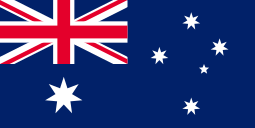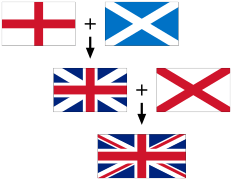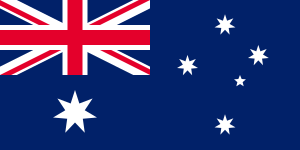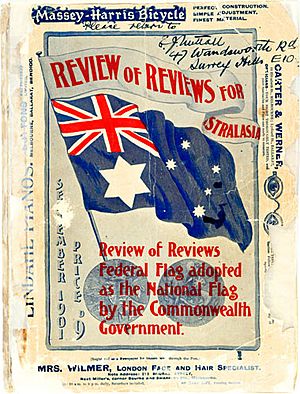Flag of Australia facts for kids
 |
|
| Use | National flag and state ensign |
|---|---|
| Proportion | 1:2 |
| Adopted | 11 February 1903 (In use from 3 September 1901) 8 December 1908 (current seven-pointed Commonwealth Star version) |
| Design | A Blue Ensign defaced with the Commonwealth Star in the lower hoist quarter and the five stars of the Southern Cross in the fly half. |
| Designed by | Annie Dorrington, Ivor Evans, Lesley Hawkins, Egbert Nutall and William Stevens |

Variant flag of Australia
|
|
| Name | Australian Red Ensign |
| Use | Civil ensign |
| Proportion | 1:2 |
| Design | A Red Ensign defaced with the Commonwealth/Federation Star at the hoist, and the Southern Cross in the fly half |

Variant flag of Australia
|
|
| Name | Australian White Ensign |
| Use | Naval ensign |
| Proportion | 1:2 |
| Adopted | First used on RAN ships in 1967. |
| Design | A defaced British White Ensign without the cross. The cross is replaced with the Southern Cross and the Commonwealth Star/Federation Star. |

Variant flag of Australia
|
|
| Name | Royal Australian Air Force Ensign |
| Use | Air force ensign |
| Proportion | 1:2 |
| Adopted | Proclaimed as a flag of Australia in 1982. |
| Design | A field of air force blue with the Union Flag in the canton, the Commonwealth Star below the Union Flag with the Southern Cross in the fly and the RAAF roundel in the lower fly. |
The flag of Australia is a special symbol for the country. It is based on the British Blue Ensign. This means it has a blue background with the Union Jack (the flag of the United Kingdom) in the top left corner.
The Australian flag also features a large white seven-pointed star. This is called the Commonwealth Star. You can also see the Southern Cross constellation on the flag. It is made up of five white stars. One star has five points, and the other four have seven points.
Australia has other official flags too. These flags represent different groups of people and parts of the government. The first design of the flag was chosen in 1901. It was part of a competition held after Australia became a federation. The flag was first flown in Melbourne on 3 September 1901. This date is now known as Australian National Flag Day.
The current flag design, with a seven-pointed Commonwealth Star, was introduced in 1908. In 1954, a law called the Flags Act 1953 officially made this flag the Australian National Flag.
Contents
- What Symbols Are on the Australian Flag?
- How Is the Australian Flag Made?
- What Are the Colours of the Flag?
- How to Show Respect for the Flag?
- A Look Back: The History of the Australian Flag
- Australian National Flag Day
- The Centenary Flag
- Other Australian Flags
- Should the Australian Flag Change?
- Images for kids
- See also
What Symbols Are on the Australian Flag?
- Parts of the Australian flag
-
Flags forming the Union Jack
The Australian flag has three main symbols. These are the Union Flag, the Commonwealth Star, and the Southern Cross.
The Union Flag: A Link to History
The Union Flag is the flag of the United Kingdom. It combines three crosses. These crosses represent the countries that make up the United Kingdom:
- The red St George's Cross for England.
- The white diagonal St Andrew's Cross for Scotland.
- The red diagonal St Patrick's Cross for Ireland.
The Union Flag on Australia's flag shows Australia's past. It reminds us that Australia started as six British colonies. It also shows the ideas on which Australia became a federation. Some people also see it as a sign of loyalty to the British Empire.
The Commonwealth Star: Representing States and Territories
The Commonwealth Star is also known as the Federation Star. When it was first designed, it had six points. Each point stood for one of the six colonies that joined together to form Australia.
In 1908, a seventh point was added to the star. This new point represents the Papua and any future territories of Australia. The change also made the star match the one on Australia's Coat of Arms.
The Southern Cross: A Bright Constellation
The Southern Cross is a very famous group of stars. You can easily see it in the southern half of the world. It has been a symbol for Australia since the first British settlers arrived.
One of the flag's designers, Ivor Evans, had a special idea for the Southern Cross. He wanted the four main stars to represent four important virtues: justice, prudence, temperance, and fortitude. These virtues were mentioned by the famous writer Dante.
The stars on the modern Australian flag have different numbers of points. The four larger stars each have seven points. The smallest star has five points. This was done to make the flag easier to make. Originally, the stars had different numbers of points based on how bright they looked in the sky.
How Is the Australian Flag Made?
The Flags Act sets out how the Australian National Flag must look.
- The Union Flag is in the top left corner, near the flagpole.
- A large white seven-pointed star, the Commonwealth Star, is in the middle of the bottom left quarter. It points towards the center of the St George's Cross in the Union Flag. Six points represent the six states, and one point represents the territories.
- Five white stars, representing the Southern Cross, are in the half of the flag furthest from the flagpole.
The stars are placed in specific spots:
- Commonwealth Star: Has 7 points, in the center of the lower left section.
- Alpha Crucis: Has 7 points, directly below the center of the right half, 1/6 of the way up from the bottom edge.
- Beta Crucis: Has 7 points, 1/4 of the way left and 1/16 of the way up from the center of the right half.
- Gamma Crucis: Has 7 points, directly above the center of the right half, 1/6 of the way down from the top edge.
- Delta Crucis: Has 7 points, 2/9 of the way right and 31/240 of the way up from the center of the right half.
- Epsilon Crucis: Has 5 points, 1/10 of the way right and 1/24 of the way down from the center of the right half.
The Commonwealth Star is 3/10 of the flag's width in size. The Southern Cross stars are 1/7 of the flag's width, except for Epsilon, which is 1/12. The inner part of each star is 4/9 of its outer size. The flag's width is measured from top to bottom.
What Are the Colours of the Flag?
The colours of the flag are not written in the Flags Act. However, the government has given official colour codes for them. These codes help make sure the flag looks the same everywhere.
| Scheme | Blue | Red | White | Source(s) |
|---|---|---|---|---|
| Pantone | 280 C | 185 C | Safe | |
| RGB (Hex) |
0–0–139 (#00008B) |
255–0–0 (#FF0000) |
255–255–255 (#FFFFFF) |
|
| CMYK | 100%–80%–0%–0% | 0%–100%–100%–0% | 0%–0%–0%–0% |
How to Show Respect for the Flag?
Guidelines for flying the flag are in the 1953 Flags Act. They are also in a government pamphlet called "The Australian National Flag". These rules say the flag should be treated with respect. It is the nation's most important symbol.
The Australian National Flag can be flown every day of the year. When flown in Australia, it must always be higher than any other flag. It should always fly freely in the air.
Government buildings must fly the flag. It must also be shown at voting places during elections. Small private boats can fly either the Red Ensign or the Australian National Flag.
The government also suggests that the flag should only be flown during daylight hours. If it is flown at night, it should be lit up. Two flags should not be on the same flagpole. The flag should never be flown upside down. This is true even in an emergency.
The flag should not touch the ground. It should not be used to cover objects before they are shown. Old or faded flags should not be displayed. They should be disposed of privately and respectfully. One way is to cut the flag into small pieces.
When to Fly the Flag at Half-Mast?
When the flag is flown at half-mast, it means something important has happened. It should be about a third of the way down the flagpole. The flag should never be flown at half-mast at night.
Flags are flown at half-mast on government buildings for these reasons:
- When the sovereign (King or Queen) dies. This lasts until the funeral. On the day a new sovereign is announced, the flag is raised to the top at 11 am.
- When a member of the royal family dies.
- When the governor-general or a former governor-general dies.
- When a famous Australian citizen dies. Flags in a local area might be flown at half-mast for a notable local person.
- When the leader of another country Australia has good relations with dies. This is usually on the day of their funeral.
- On ANZAC Day, the flag is at half-mast until noon.
- On Remembrance Day, flags are at the top until 10:30 am. They are at half-mast from 10:30 am to 11:03 am. Then they are raised to the top for the rest of the day.
The government has an email service called the Commonwealth Flag Network. It tells people when to fly the flag at half-mast. It also shares information about national days of celebration.
Using the Flag for Business
The Australian National Flag can be used for business or advertising. You don't need special permission. But it must be used respectfully. The flag should be shown completely and correctly. It should not have words or pictures printed over it. Other objects should not cover it. All parts of the flag must be clear.
If more than one flag is used, the Australian flag should be first. This usually means on the left. For example, the Collingwood Football Club had to change its logo. Their logo used to show the flag, and they had to reverse it to follow this rule.
A Look Back: The History of the Australian Flag
Before 1901, Australia was made up of six separate British colonies. The Union Flag was used in Australia from 1770. This was when Lieutenant James Cook landed at Botany Bay. It was also used when Europeans first settled in 1788.
Each colony had its own flag, usually based on the Union Flag. As Australians started to feel more like one nation, new unofficial flags appeared. In the 1800s, people tried to design a national flag.
One early flag was the National Colonial Flag from 1823–1824. It had a red cross on a white background. It also had an eight-point star on each arm of the cross and the Union Flag in the corner.
The Federation Flag became very popular later in the century. This was when people started talking more about Australia becoming one country. It was similar to the National Colonial Flag, but the cross was blue.
Other flags, like the Eureka Flag from 1854, also showed the Southern Cross. The Anti-Transportation League Flag was similar to today's flag. It had the Southern Cross, but no Commonwealth Star. The stars were gold and had eight points. This flag was used only for a short time.
The Eureka Flag is often seen as the first "Australian" flag. It was the first important design that had the Southern Cross but not the Union Flag. The Murray River Flag is still used today by boats on Australia's main waterway.
|
The 1901 Flag Design Competition
As Australia became a federation, people started thinking about an official flag. In 1900, a newspaper in Melbourne held a design competition. The winning design had to include the Union Flag and the Southern Cross.
Later, the new Commonwealth Government held its own official competition in April 1901. Over 32,000 designs were sent in. Many designs included the Union Flag and the Southern Cross. Some even showed native animals playing cricket!
The designs were displayed in Melbourne. Judges took six days to choose a winner. Five designs were almost the same, so their designers shared the prize money. The winners were:
- Ivor Evans, a 14-year-old schoolboy.
- Leslie John Hawkins, a teenager from Sydney.
- Egbert John Nuttall, an architect.
- Annie Dorrington, an artist.
- William Stevens, a ship's officer from New Zealand.
The first winning flag design had a six-pointed Commonwealth Star. The Southern Cross stars had different numbers of points. This was based on how bright they were in the sky.
The new flag was not liked by everyone at first. Some thought it looked too much like the flag of Victoria. The Prime Minister, Edmund Barton, even suggested another flag. But the British Admiralty chose the competition winning design.
|
On 3 September 1901, the new Australian flag flew for the first time. It was raised from the dome of the Royal Exhibition Building in Melbourne. The Governor-General's wife, Hersey, Countess of Hopetoun, unfurled the flag. This day is now known as Australian National Flag Day.
In 1903, King Edward VII officially approved the design. The published version changed all the Southern Cross stars to seven points, except for the smallest one. This is almost the same as the flag we have today. The only difference was the Commonwealth Star, which still had six points until 1908.
Blue or Red Ensign?
For a long time, there was confusion about which flag to use. The Red Ensign was usually flown by private citizens on land. The Blue Ensign was for government use.
This confusion lasted until the Flags Act 1953. This law officially made the Blue Ensign the national flag. The Red Ensign became the flag for Australian merchant ships.
Even after the law, Red Ensigns were still used in Anzac Day marches until the 1960s. Today, the Red Ensign can be flown on land alongside the national flag on Merchant Navy Day.
Replacing the Union Jack
Over time, the Australian Blue Ensign slowly replaced the Union Jack in official use. In 1904, the Australian Parliament said the Blue Ensign should be flown on all forts, ships, and public buildings.
In 1908, the Australian Army started using the "Australian Ensign" instead of the Union Flag at military places. From 1911, it was used for saluting at army parades.
The Royal Australian Navy (RAN) was formed in 1911. They were told to fly the British White Ensign at the back of their ships and the Australian flag at the front. The British White Ensign was replaced by a special Australian White Ensign in 1967.
Even with the new Australian flag, the Federation Flag remained popular until the 1920s. It was even flown at some official events.

In the 1920s, there was a debate about whether the Blue Ensign was only for government buildings. In 1924, it was agreed that the Union Flag should be the main National Flag. Many Australians still saw the Union Flag as the National flag until the 1970s.
In 1940, the Victorian government allowed schools to buy Blue Ensigns. This meant private citizens could use them too. Prime Minister Robert Menzies encouraged everyone to use the Blue Ensign.
On 4 December 1950, Prime Minister Robert Menzies declared the Blue Ensign as the National flag. In 1951, King George VI approved this.
The Flags Act 1953 made this official. Queen Elizabeth II approved the Act on 14 February 1954. This happened during her visit to Australia. The Act gives the Governor-General the power to name Australia's flags and set rules for their use.
In 1998, the Flags Act was changed. It now says that any change to the national flag must be approved by a public vote. This vote must offer the current flag alongside any new designs.
Australian National Flag Day
In 1996, the Governor-General, Sir William Deane, announced that 3 September would be Australian National Flag Day. This day celebrates the first time the flag was flown in 1901.
On Flag Day, ceremonies are held in schools and towns. The Governor-General and other leaders often attend or make statements. Australian National Flag Day is not a public holiday.
The Centenary Flag
On 3 September 2001, 100 years after the flag was first flown, a special flag was presented. This "Centenary Flag" was given to the Prime Minister by the Australian National Flag Association. It was a current Australian National Flag with a seven-pointed Commonwealth Star.
This flag has a special band with an inscription. It says the flag was presented to mark 100 years since the first flag flying. The Centenary Flag is now used as the official flag for important events. These include the opening of new parliament terms and visits from leaders of other countries.
Other Australian Flags
The Flags Act 1953 allows the Governor-General to name other flags as official flags of Australia. Five flags have been named this way.
The first two were the Royal Australian Navy Ensign and the Royal Australian Air Force Ensign. These are the flags used by the Royal Australian Navy and the Royal Australian Air Force. The Australian Army does not have its own flag. Instead, they protect the National Flag.
The Navy and Air Force used British flags until 1948 and 1967. Then they adopted their own ensigns based on the Australian National Flag. The current Navy and Air Force Ensigns were officially named in 1967 and 1982.
In 1995, the Aboriginal Flag and the Torres Strait Islander Flag were also made official flags of Australia. This was seen as a step towards reconciliation. However, some indigenous people felt the government was taking over their flag.
The Australian Defence Force Ensign was named in 2000. This flag is used when more than one part of the military is involved. For example, at the Australian Defence Force Academy.
|
Besides these seven flags, there are other official flags. These include the Australian Civil Aviation Ensign and Australian Customs Flag. There are also flags for the Governor-General and state and territory flags.
Special Flag Variants for the Prime Minister
Two special versions of the Australian flag have been used only on the prime minister's car.
|
Should the Australian Flag Change?
There has been an ongoing discussion about changing the Australian flag. Some people think the Union Flag should be removed from the corner. This debate became stronger before Australia's 200th birthday in 1988.
Former Prime Minister Paul Keating supported changing the flag. He said that Australia's symbols would not be complete with another country's flag on it.
There are two main groups in this debate:
- Ausflag (started in 1981) wants to change the flag.
- Australian National Flag Association (ANFA) (started in 1983) wants to keep the current flag.
Those who want to keep the flag say it has important historical meaning. Those who want to change it say the current flag does not truly show Australia as an independent and multicultural nation. They also say it looks too much like other flags, such as those of New Zealand or Cook Islands.
The government under John Howard supported keeping the flag. In 1996, they officially recognized Australian National Flag Day. In 1998, they changed the Flags Act. This change means any flag design change needs a public vote. In 2004, they made all schools getting federal money fly the Australian flag.
Ausflag often campaigns for flag changes during big national events. ANFA promotes the current flag through events like National Flag Day.
Surveys show that most Australians want to keep the current flag. A 2010 survey found that 66% of people did not want a new flag design. The Australian flag is seen as a very important national symbol.
Images for kids
-
Australian flag at half-mast on Remembrance Day
-
The Australian flag and the Union Jack during an Anzac Day ceremony in 1937
-
The Australian national, Aboriginal and Torres Strait Islander flags as they are often displayed at official events
-
A poster calling for a redesign of the Australian Flag, released by Ausflag in 2000 to coincide with the 2000 Summer Olympics
See also
 In Spanish: Bandera de Australia para niños
In Spanish: Bandera de Australia para niños
































